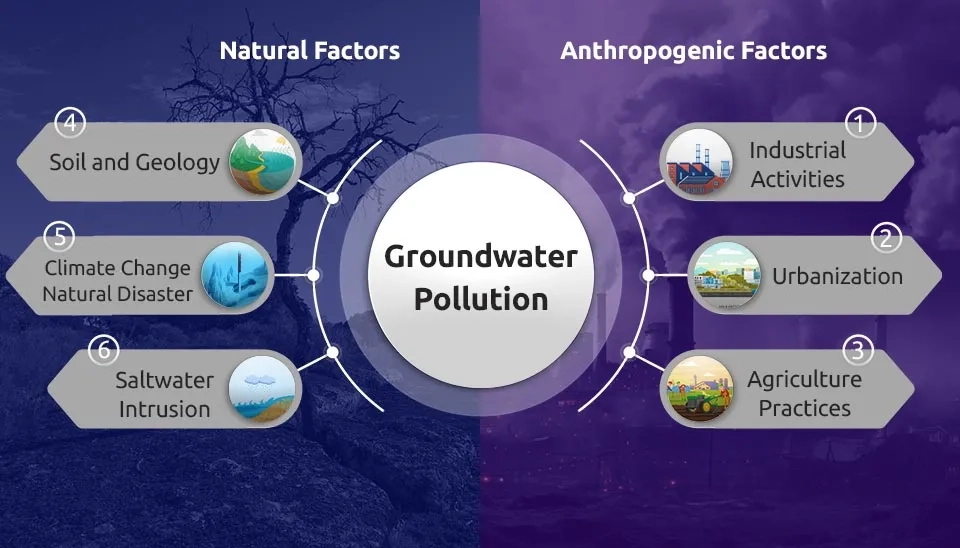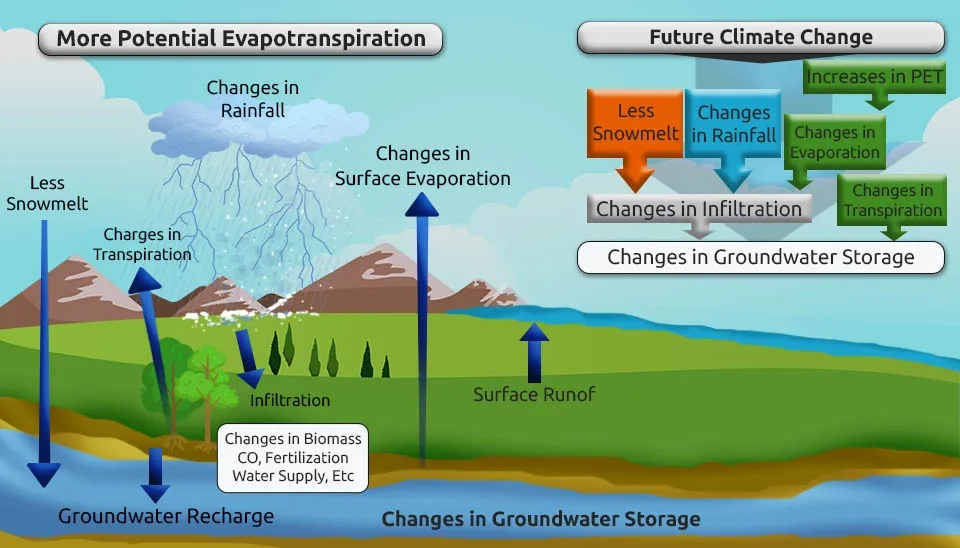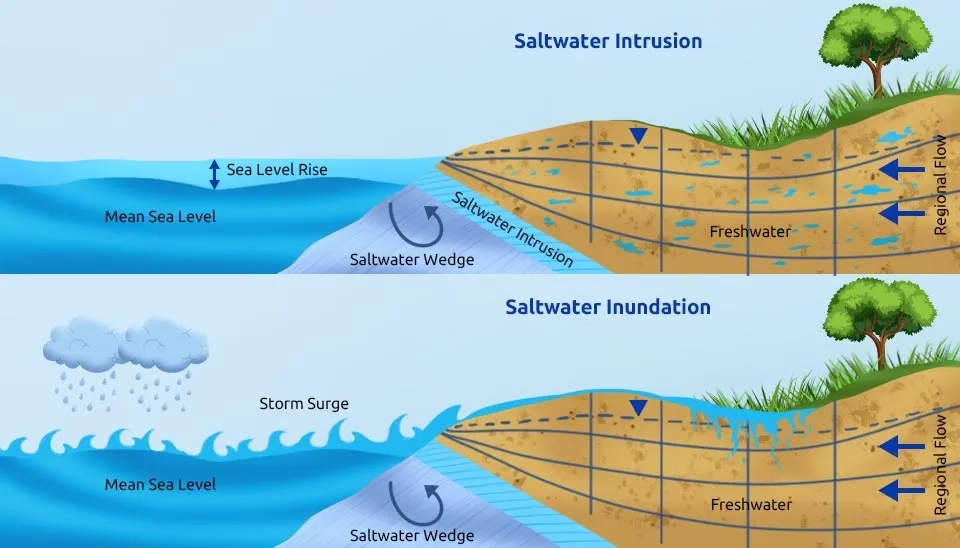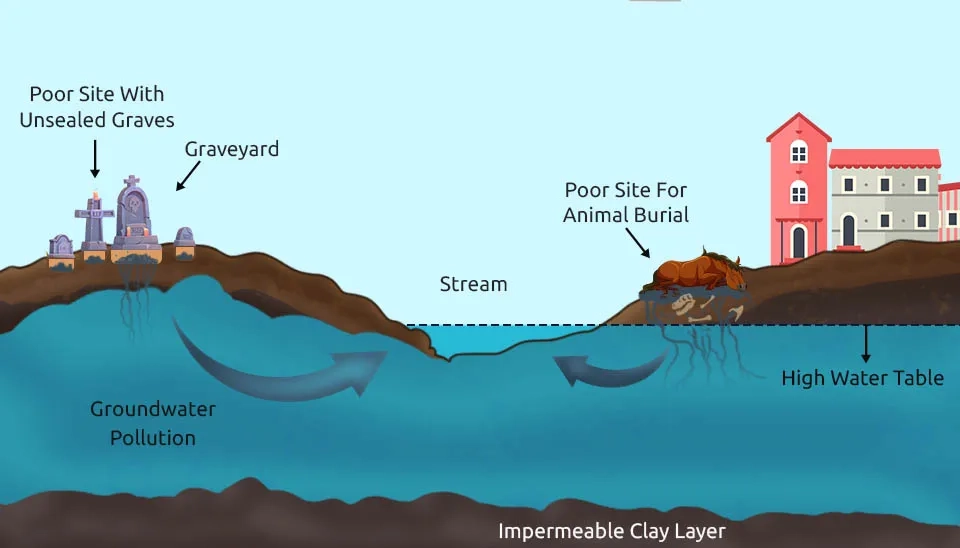
99% of freshwater that exists in liquid form on the planet is “invisible water sources” or groundwater. These sources provide more than 50% of the domestic needs and 25% of the world's agricultural needs, but under the influence of many human factors such as the development of industries, agriculture, and urbanization, it has been exposed to many polluting sources. Some natural factors such as climate change have also increased the rate of groundwater pollution (UN WWDR, 2022).
Today, the rate of groundwater withdrawal exceeds its recharge, and if the consumption pattern is not corrected and pollutants are not prevented from entering the aquifers, irreparable risks such as subsidence and water scarcity will affect large areas and lead to damage to human health. In this article, we will examine the most important factors that threaten and pollute groundwater, which will be a scary future for all creatures on the planet without preventing and controlling them.

1. Natural Factors
The location of the aquifer can expose them to pollution caused by natural factors. Some places are more exposed to natural hazards such as floods, earthquakes, hurricanes, and volcanoes, while others located in coastal areas are exposed to saltwater intrusion. Aquifers can be carbonate or alluvium, which affects their vulnerability to various factors. The following will examine the main natural factors of groundwater quality degradation.
1.1. Soil and Geologic Properties
Groundwater is generally of high quality, but due to the area's geology, soil characteristics, bedrock, and type of aquifer, it can be exposed to hydrogeochemical processes such as dissolution and ion exchange reactions. Water is a solvent that can dissolve soil organic and mineral substances. Although the solubility of mineral and organic materials is different and may take years, it will eventually change water quality characteristics such as hardness and pH. It should be noted that the water that recharges the groundwater through precipitation or sewage may also react with soil particles and cause a decrease in the quality of the groundwater. Another relatively rarer thing is the presence of natural radionuclides, considered a source of nuclear pollution and can dissolve in water and endanger the lives of many humans and other animals. Of course, atomic contamination of groundwater can also be caused by human activities (Kojo Abanyie et al., 2023).
1.2. Climate Change and Natural Disasters
Floods and droughts are extreme events whose frequency have been increased due to climate change impacts. High-intensity rainfall and flood occurrence contribute to groundwater pollution by surface contaminants. Also, drought events and increasing evaporation, the other consequences of climate change, can reduce the volume of surface resources that recharge the groundwater. Apart from floods and droughts, whose share is more than 60% among water-related natural disasters, Other natural events such as volcanic eruptions, earthquakes, tornadoes, and tsunamis can also cause pollutants to enter the groundwater (Akhtar et al., 2021).

1.3. Saltwater Intrusion
Did you know that over 1 million people in coastal areas rely on groundwater for freshwater? (Han and Currell, 2022) Learn more about why groundwater is crucial for coastal communities. Groundwater is exposed to saltwater intrusion due to its interface with seawater. When the groundwater level exceeds the sea level, water movement towards the sea prevents salt water from entering the aquifer. However, due to natural events such as storm surges, coastal floods, hurricanes, tsunamis, subsidence, and climate changes, the sea level may be higher than the aquifer level and cause saltwater intrusion. Of course, this phenomenon may also occur due to groundwater overexploitation and lowering its level (Basack et al., 2022).

2. Anthropogenic Factors
Humans, in their efforts to meet development needs and address growing demands, engage in a variety of industrial, agricultural, and urban activities. Their activities—whether intentional or unintentional—have a profound impact on water resources by introducing a wide range of pollutants into the environment. In agricultural areas, the use of fertilizers, pesticides, and irrigation systems leads to the leaching of chemicals into groundwater and contaminating it over time. Urban areas contaminate through waste discharge, leakage from sewage systems, and the accumulation of surface pollutants that ultimately infiltrate underground aquifers. Industrial activities compound the issue by discharging untreated, inadequately treated, and toxic chemicals, which directly affect the quality of water bodies and groundwater. In the sections that follow, these three major factors—agriculture, urban development, and industrial activities—will be examined in greater depth to understand their individual and combined impacts on groundwater resources.

2.1. Industrial Activities
Industries and factories are sources of waste production and effluents that can seriously pollute water resources and the environment due to improper disposal and untreated wastewater. In addition to polluting surface water sources, sewage discharged into rivers also pollutes underground sources by penetrating the soil. In addition, many industries use injection wells for waste disposal, which can cause chemicals to enter the aquifers if they are not correctly placed. Also, gaseous wastes such as sulfur dioxide and nitrogen dioxide from chimneys and exhaust pipes cause acid rain. In addition to industries, mining processes can cause surface and underground water pollution. The mine-water drainage has relatively high sulfate, iron, and other metal concentrations; low pH; and high acidity. Water used to reduce mine dust, equipment cooling, washing, processing, etc. can accumulate harmful compounds (Agboola et al., 2020).

2.2. Urbanization
Another source of groundwater pollution is urbanization practices. Changing land use, creating dense buildings, and building roads are actions that are carried out to develop urbanization. Land modification alters the vegetation, the permeability or porosity of soil, topography, and surface water properties which all influence recharging and groundwater movements (Burri et al., 2019).
The wastewater from our daily activities, which is also known as grey water or black water, as well as wastewater from shops, restaurants, schools, offices, and medical centers, enter the wastewater collection systems. This effluent can contaminate groundwater sources in case of any leakage from pipes and septic tanks. In addition, fuel storage tanks, gas stations, garbage disposal centers, and landfills can also be other polluting sources in cities. Water pollution by graveyards is also an issue that should be considered because many of them are located in places that are connected to groundwater. During the process of human decomposition, an amount of 0.4 to 0.6 liters per 1 kg of leachate is produced and enters the soil. Leachate includes 10% organic compound, 30% salts in nitrogen ions, phosphorus, Cl, Na, and various metal compounds (Cr, Cd, Pb, Fe, Mn, Ni), and 30% water and has high conductivity, pH, and BOD value (Zychowski and Bryndal, 2014; Khatry and Tyagi, 2014).

2.3. Agriculture Practices
Pesticides and fertilizers are 2 types of agrochemicals used to boost crop production, repel pests, and destroy weeds. Overdosing and repeated use of pesticides and fertilizers due to poor literacy, lack of training, and inappropriate mixing contribute to water resource contamination. Inorganic or chemical fertilizers contain a considerable value of nitrogen, phosphorus and potassium and also heavy metals. it is estimated that the use of N, P, and K will be grown by 172%, 175%, and 150% by the year 2050. Pesticides divided into 4 general categories which are: insecticides, herbicides, rodenticides, and fungicides. They are used to eliminate pests, weeds, and insects but because of their toxic essence, they can also lead to human health disorders and poisoning. Application of some pesticides such as DDT and HCH are prohibited in developed countries but they are still used in many countries. Through rainfall and irrigation, all of the mentioned contaminants are absorbed by the soil, reaching the groundwater, and can threaten human health (Khan et al., 2018; Srivastav, 2020).

3. Conclusion
All human activities and in general the continuation of life require access to healthy water sources, most of which are groundwater. These industrial activities and urban development produce significant wastewater after water consumption, which requires that wastewater collection systems be designed in such a way that untreated wastewater does not enter nature and water sources. It is also necessary that the materials used in the agricultural sector, including fertilizers and pesticides, are used in a controlled manner so as not to pollute water and soil sources, therefore agricultural practices can be one of the significant sources of groundwater pollution in several countries. In addition to the effect of human activities, natural hazards, and disasters are also effective in the entry of pollutants into the aquifer and can accelerate the reduction of the quality of underground water tables.
